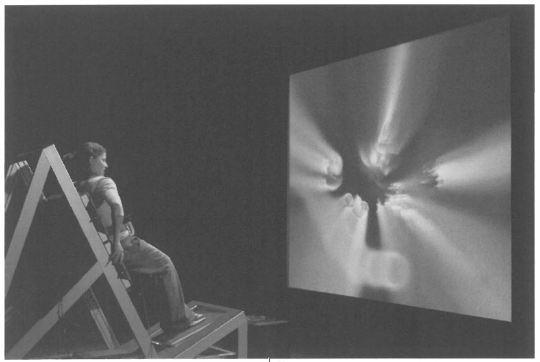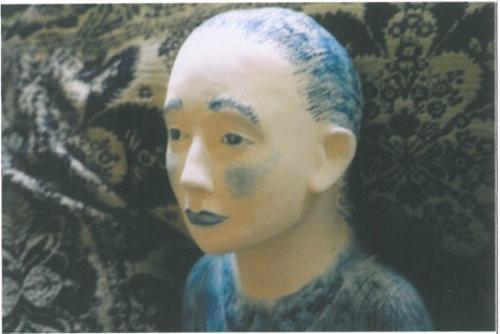
Intimate Transactions 3: 2005 is an innovative and interactive installation work that enables two people in separate locations to simultaneously interact with one another. To do this, each person employs the interface of a 'bodyshelf', a specially designed piece of 'smart furniture' where simple movements of the body directly 'influence an evolving world created from digital imagery, multichannel sound and tactile feedback.' Consequently each participant is immediately and inescapably thrust into a complex of unfolding sensual relationships and experiences that prove to be both surprisingly intimate and emotionally very moving.
Intimate Transactions 3: 2005 is the third and final instalment of the Intimate Transactions project which began in 2003. For this presentation the two locations were the QUT Creative Industries Precinct, the block, in Brisbane and the Australian Centre for the Moving Image in Melbourne. The installation is the work of the Transmute Collective, which was founded in 1998 and is currently based in Brisbane. It consists of three core members, Keith Armstrong (Artistic Director), Lisa O'Neill (Performer/Choreographer) and Guy Webster (Sound Designer).
It is no exaggeration to say that for the viewer-participant, the piece generates a staggeringly beautiful and integrated sensory experience. The visuals are all screen-based and the 'creatures' and objects that one encounters within this piece are all iridescently beautiful and fragile. When one's pictorial avatar touches or joins with them, one is positioned into a new optical space and a range of exquisitely varied, three-dimensionally resonant soundscapes. The movement of one's body generates movement on the screen to gain access to the various spaces to which each creature is a portal. This somehow works to bond you more closely to what you are perceiving – to move is to see, hear, be touched and finally communicate.
At times the experience is uncanny because this incarnation of Intimate Transactions allows for the merging with an image-entity which is under the control of another person. When engaged with the work a subtle form of sensory intimacy and connection begins to form with this other. It is almost as though one encounters an alien consciousness and slowly becomes drawn into a ritual communication or dance that enables a precious, non-physical union to take place.
Once united, however, the issue of discovering just how to negotiate existence within what has now been transformed into a new hybrid form becomes a priority. It necessitates becoming attuned to the other's movement-language. Sometimes it was difficult and awkward as one met with or presented resistance. On occasion the best option was to do was nothing at all and simply surrender all movement to the other. The other person could then lead and share with you the world they had discovered or created. It was a tender experience.
Intimate Transactions is very much a prescient glimpse into the future, an example what art can, and probably will, become. It is a remarkable work and one that is now attracting serious international attention with exhibitions being planned for the United Kingdom and for Europe. Even more significantly, the piece has been the recipient of an honorary mention in the Interactive Arts category at the Prix Ars Electronica (Cyber arts 2005), where the work will also be exhibited.
Intimate Transactions was a complex work to realise. Apart from the three core members, as is increasingly typical of new media projects this project would not have been possible without the huge team of specialist collaborators (at last count over twenty five) which had been assembled for its realisation. In addition this project was developed in partnership with the Australasian CRC for Interaction Design (ACID), QUT Creative Industries Research and Applications Centre (CIRAC) & Precincts, the Performance Space, RMIT SIAL, The Australia Council, Arts Qld, and the Australian Centre For The Moving Image (ACMI). This clearly was not a simple organisational task and one can only wonder at the enormity of its logistics, and - of course - wait with some impatience for the next project of the Transmute Collective.












